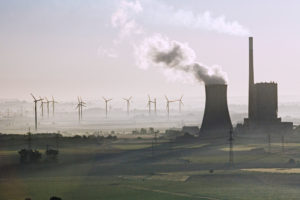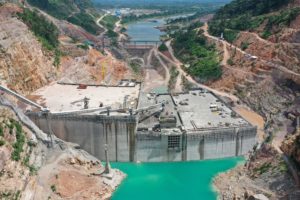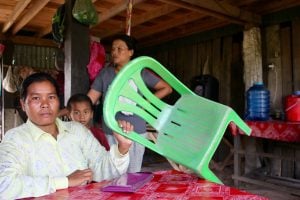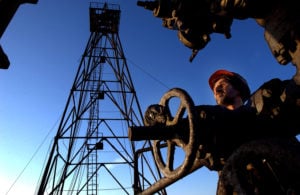Late last year, local activists celebrated an unexpected victory against the Kenyan government. They’d succeeded in protecting Lamu, a county on Kenya’s northern coast which is home to the UNESCO World Heritage Site of Lamu old town, against plans to build the country’s first coal-fired power plant on the mainland nearby.
Three Chinese state-owned enterprises had got behind the project in 2015. Local communities and environmental activists then launched a petition, demonstrated and filed a lawsuit against it before a court ruling suspended the project’s permit in 2019. Major financiers, notably the Industrial and Commercial Bank of China (ICBC), pulled out. And finally, in November 2020, the Kenyan government cancelled the project.
For Chinese companies looking to expand their presence along the Belt and Road, the failed project is a lesson in the risks of investing in environmentally damaging projects that lack community support. Once again, it’s prompted calls for China to adopt stronger regulations to govern overseas investments.
Victory over a coal-powered Goliath
Vision 2030, an initiative launched by the government in 2008, aims to make Kenya an industrialised country. Unfortunately, the vision’s aspiration towards sustainability is undermined by the push for coal power to serve the growing economy.
The government proposed a 1-gigawatt coal plant for Lamu county in 2013. Its smokestack would be 210 metres, the tallest structure in East Africa. Two years later, ICBC committed US$900 million of export credit to the project. Together with its affiliate, South African Standard Bank, the banks put forward a further $300 million, amounting to 60% of the financing cost. Two state-owned companies, Power Construction Corporation of China and China Huadian Corporation, planned to build and operate the plant, respectively.
The location would be Lamu’s lush mangrove coast, a mere 20km from the old town on Lamu Island. This World Heritage Site is East Africa’s oldest and best-preserved Swahili town, a fusion of Arabic, Persian, Indian and European architecture. The narrow streets are lined with pale coral stone houses and carved wooden doors. Travel is by foot, bicycle or donkey as cars are not allowed.


Amu Power, a consortium of Kenyan companies, initiated the coal power project and planned to run it. By the time it was suspended, Amu had already cleared several vegetable and maize farms. The people of Lamu were worried about air pollution from the plant and how its discharge might threaten the marine life that’s vital to the local economy.
Concerns extended beyond Kenya. UNESCO and the IUCN (International Union for Conservation of Nature) called on the government to review the coal plant’s environmental and cultural impacts. Activists warned the project would make it more difficult for Kenya to meet its commitments under the Paris Agreement.
To keep Lamu coal-free, a few environmentalists and civil groups took the National Environment Management Authority and Amu Power to the National Environmental Tribunal in 2016. Three years later, in June 2019, they won the case. The judgment affirmed that the environmental and social impact assessment (ESIA) failed to adequately consider pollution from the plant or its negative impacts on people, flora and marine life. The judgement also found that public participation had been insufficient. The plant would need a new ESIA before its construction could resume.
Civil society likened the legal victory to David versus Goliath. Investors started to reconsider their involvement. General Electric, which was planning to invest one-fifth of the project’s equity, withdrew a few months later. The Chinese investors remained silent.
Then last November, Save Lamu, one of the local groups that filed the legal case, learned that ICBC had also withdrawn due to the project’s “environmental and social risks”. Concerned about whether other banks would step in to fill the gap, the Kenyan government decided to cancel the project a few days later.
A lesson for investors
Christoph Nedopil Wang, founding director of the Green Belt and Road Initiative Center, pointed out that companies must ensure community support for projects. “This is particularly important in states based on the principles of democracy and the rule of law, where agreements between businesses and government are insufficient to ensure the implementation of a project.”
Save Lamu heard local concerns about the coal plant from the start. It held meetings with fishermen, women and the elderly. It visited coal-fired power plants in South Africa and India. “After seeing the impacts, we knew this is not what we wanted, despite our being underdeveloped,” said Khadija Shekuwe, a coordinator at the organisation.
“Why don’t they focus on renewable resources? Why don’t they pursue that advantage without destroying people’s health and the environment?” Shekuwe said. The country has a promising renewable energy sector. It is already the site of the largest wind power project in Africa.
Their efforts to halt the project, which included a petition in early 2016, had little impact. The local authorities issued permits for the project in September that year without responding to those opposing the project.
It’s a project that highly affects communities. They need to listen to what the communities say.Khadija Shekuwe, coordinator at Save Lamu
Filing a lawsuit became the only way to halt the construction and secure enough time to lobby against the project, said Omar Elmawi, the campaign coordinator at the coalition DeCOALonize which works with Save Lamu.
Meanwhile, environmentalists sought to lobby the Chinese investors, especially ICBC. They posted messages on the bank’s social media channels and wrote several open letters in English and Chinese. Shekuwe recalled meeting an ICBC representative at a conference and hoping she would deliver their message, but that never happened.
The environmentalists protested at the ICBC’s office and the Chinese embassy in Nairobi in June 2019. This led to a meeting with the Chinese ambassador, the only chance the campaigners had to communicate with the Chinese side directly. In response to their concerns, the ambassador affirmed that only Kenya’s people could decide whether to build the power plant. A representative from one of the three Chinese companies attended the meeting, and introduced how coal-fired power plants were doing well in China, recalled Elmawi. In a previous interview, Elmawi told China Dialogue they believed the Chinese didn’t take their petitions seriously until they took to the streets.
Shekuwe and her colleagues were frustrated by the companies’ silence. “It’s a project that highly affects communities. They need to listen to what the communities say. They need to see the environmental impact of their project,” she said.

These are regular complaints levelled against Chinese companies. State-owned enterprises rarely speak to the Chinese media or public and generally do so only for self-promotion. The same approach is often followed overseas. Any public communication may need approval from the headquarters in China, and Chinese companies often discourage their employees from interacting with local people. This means company leaders may not be aware of investment risks in time.
Liu Jinmei, a lawyer with Friends of Nature in Beijing, has been involved in many environmental lawsuits in China. She said companies should improve their public communication and release more information. “They can resolve many risks by doing that. Indeed, not doing so will increase conflict.”
The victory set a precedent for community-led campaigns across the world by garnering public support through the collaboration of local groups and together with international civil society organisations. It was a “novel and remarkable win”, according to UNEP (the United Nations Environment Programme) website: “This case represents a win for the public participation of locals in environmental governance, for environmental law enforcement and for ensuring that businesses and governments are answerable to communities.”
The groups already had experience in defending themselves against big business and government plans. Save Lamu was founded to raise the community’s voice in the face of a project to build an extensive port on the island. When Kenya introduced the idea of the port to connect Ethiopia and South Sudan in 2009, there was little public participation and the environmental impact assessment lacked detail. With the group’s support, fishers filed a lawsuit against the government after they lost grounds to the port’s construction. In 2018, Kenya’s high court judged the project violated the community’s rights to information, to a clean and healthy environment, and to culture. The court awarded the Lamu fishermen compensation totalling US$17 million.
Another lawsuit gathering storm
In Ghana, civil group A Rocha Ghana hopes to apply lessons from the Lamu case in its mission to defend the Atewa forest. In July 2020, the group led a few Ghanaian environmentalists to sue their government to stop a proposed mining project in the region, also backed by Chinese finance.
Soon after taking office in early 2017, the current government signed a memorandum of understanding with China to finance new infrastructure such as roads and hospitals. In exchange, Ghana would pay back the loans with bauxite. The state-owned Sinohydro Corporation and China Construction Bank were behind the deal.
For the Ghanaian environmentalists, Atewa is the finest example of an upland evergreen forest in the upper Guinean forest region. It provides habitats for hundreds of endangered species. As the origin of three major rivers, it is also a clean water source for millions of people. Therefore, Ghanaian and international conservation groups have argued Atewa should be designated a national park. This proposal enjoyed support from a previous government.
As long as there are still a lot of non-green projects, China is undermining its own philosophy that says green is goldChristoph Nedopil Wang, Green Belt and Road Initiative Center
At home and abroad, Chinese official media praised the infrastructure project for promising to improve life for the people of Ghana. Daryl Bosu, deputy national director of A Rocha Ghana, told China Dialogue that such projects should not be built at the cost of destroying a critical ecosystem like the Atewa. In three years, their petition to the Ghanaian government and Chinese investors received no response. Bosu believed filing a lawsuit was the only choice to save the forest.
“Although the Chinese companies are not involved in the bauxite mining, the payment certainly stimulates the host country to search for bauxite in the forest,” said Zhang Jingjing, an environmental lawyer and founder of the Center for Transnational Environmental Accountability. “If the NGOs win the case, Chinese companies may face the risk of not being able to collect on their debts,” she added.
In Zhang’s opinion, Chinese investors are obligated to follow international treaties signed by the Chinese government. In 2018, an Ecuadorian court ordered a Chinese private corporation to suspend gold and silver mining in a nature reserve, home to the Kañari indigenous communities. Zhang testified for the communities, citing China’s affirmation of indigenous people’s rights worldwide when the government endorsed the UN Declaration on the Rights of Indigenous People in 2007. “In practice, implementation is not good enough,” she added.
What to do?
In 2017, the Chinese government issued a guideline for the green Belt and Road Initiative (BRI). In it, the government commits to help other countries achieve the 2030 Sustainable Development Goals. Last December, the BRI International Green Development Coalition (BRIGC), a government-backed coalition, suggested a system for classifying investments based on their climate change, biodiversity and pollution impacts. A coal-fired power plant and a project that damages critical biodiversity areas would be considered unacceptable according to the system. However, these principles are not mandatory. Companies are only required to register their foreign investments, there is no vetting process and little attention is paid to environmental risks, according to Liu Jinmei.
Experts suggest China should issue stricter regulations to supervise overseas investment, including the power to punish breaches. This is because the BRI is driven mainly by the government rather than the market, with state-owned companies playing a significant role. “With a top-down financing system like China, the government is responsible for ensuring that its overseas finance is green. As long as there are still a lot of non-green projects, China is undermining its own philosophy that says green is gold,” said Nedopil Wang.
Civil society can act as a watchdog to contain the impacts of investments. But in Zhang Jingjing’s opinion, Chinese civil society organisations have only just started to look beyond China’s borders. They have exerted little pressure on companies because they lack capacity and experience. “It leads to the government taking the major responsibilities.” Legislation is needed.
“Seven years after the launch of the Belt and Road Initiative, it’s time for China to enact a foreign investment law and review its investments’ impact on the environment, climate change and society,” said Zhang.
Correction: an earlier version of this article stated that “a representative from one of the three Chinese companies attended the meeting, but he didn’t say a word.” This representative introduced the situation of coal-fired power plants in China at the meeting.









![Indian father riding on at electric three wheeler with his child [image: Suman Kumar / Alamy]](https://dialogue.earth/content/uploads/2021/05/2BHEFB6-300x200.jpg)